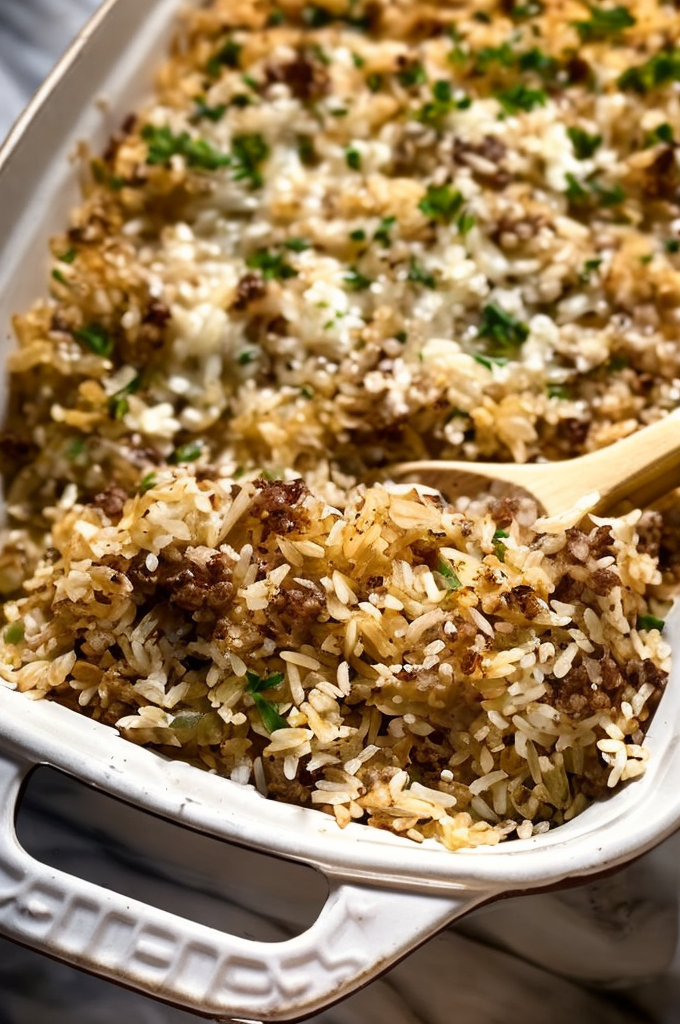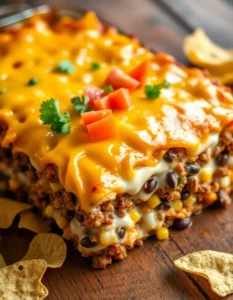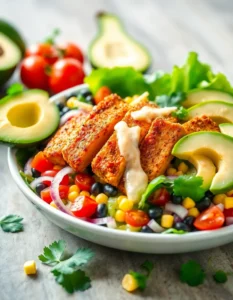French Onion Ground Beef and Rice Casserole: A Hearty and Flavorful Delight
Embrace the comforting flavors of a French Onion Ground Beef and Rice Casserole, a true classic that’s perfect for any weeknight dinner. Combining savory ground beef with aromatic onions, this casserole is layered with flavor and warmth. The dish brings together the richness of caramelized onions and the hearty texture of beef and rice.
This meal not only captivates with its delightful taste but also provides a sense of nostalgia, reminiscent of traditional family meals. Enveloped in a creamy sauce and topped with melted cheese, every bite delivers comfort and satisfaction. Whether you’re a cooking novice or a seasoned chef, this delightful casserole defines ease and heartiness.
Quick Recipe Highlights
- Flavor Profile: Indulge in a savory mix of caramelized onions, rich beef, and gooey cheese that complement perfectly with fluffy rice.
- Texture: A delightful balance of tender beef and rice, melted cheese, and crisped topping creates a symphony of textures in every bite.
- Aroma: The casserole exudes an inviting aroma of caramelized onions and freshly cooked beef that fills your kitchen with warmth.
- Visual Appeal: A golden-brown crust sits atop a creamy and inviting mix, enhanced by its delightful cheese sheen and herb sprinkle.
- Skill Level Needed: Easy; ideal for beginners and experienced cooks alike, requiring basic cooking techniques and equipment.
- Special Equipment: A sturdy casserole dish, a deep skillet, and a sharp knife for preparing ingredients seamlessly.
Recipe Overview
- Difficulty Level: This dish is accessible and straightforward, involving easy-to-follow steps that guarantee success for cooks of all levels.
- Category: Perfect as a main course, this casserole also serves beautifully as a side dish for larger feasts.
- Cuisine: Rooted in French culinary traditions, adapted to celebrate hearty American comfort food styles.
- Cost: Affordable, with ingredients commonly found in your pantry or at local grocery stores, offering great value for the deliciousness.
- Season: Ideal for autumn and winter, when warm and cozy meals are most appreciated, though enjoyable year-round.
- Occasion: Versatile for family dinners, potlucks, or casual gatherings, providing a heartwarming option on any menu.
Why You’ll Love This Recipe
Taste and texture come together with the sweet caramelization of onions contrasting the savory beef and creamy rice. The melted cheese topping adds a layer of richness, marrying the flavors harmoniously to provide a gratifying mouthfeel.
Convenient to prepare, the French Onion Ground Beef and Rice Casserole requires minimal effort, making it perfect for busy weekdays. Simple, wholesome ingredients allow for an easy process and a satisfying result.
Packed with essential nutrients from beef and whole grains, this dish caters to health-conscious diners while not compromising on flavor. Onions supply antioxidants while the protein-rich beef sustains energy and satiety.
This casserole shines as a crowd-pleaser during social events with its universal appeal and comforting taste. Its aroma and flavors can spark conversations and bring warmth to gatherings, enhancing the dining experience.
Cost-effective and easy to assemble, this recipe is friendly on the wallet and demands no fancy ingredients, yet delivers a satisfying gourmet feel. Making use of pantry staples, it’s both accessible and delightful.
Historical Background and Cultural Significance
Inspired by the French tradition of crafting flavorsome stews with caramelized onions and cheese, this casserole carries the essence of rustic, homely French cooking, infused with a modern American twist.
French cuisine impacts global culinary practices, and the integration of beef and rice into this dish reflects the adaptability of French techniques combined with hearty American family favorites.
The recipe evolved from classic onion soup, adapting the rich onion flavor and combining it with robust American casseroles, enhancing its popularity as a versatile comfort food staple.
As it spread through various regions, this dish morphed to suit local tastes and available ingredients, ensuring variations that demonstrate the adaptability and enduring appeal of this culinary fusion.
Ingredient Deep Dive
Ground Beef: A key ingredient offering a rich source of protein, appreciated for its versatility and ability to absorb flavors. Select high-quality ground beef with a balanced fat content to ensure juiciness.
Onions: Caramelized to perfection, onions deliver sweetness and depth, contributing antioxidants and micronutrients. Opt for large yellow onions known for their robust flavor and easy adaptability.
Rice: The foundation of the casserole, rice offers texture and heartiness while absorbing the savory juices. Choose long-grain white or basmati for the fluffiest, most charming result.
Cheese: Topping the casserole with melted cheese provides a rich, creamy finish. Cheddar or Gruyère are excellent for their meltability and full-bodied flavor profile.
Common Mistakes to Avoid
- Over-browning onions can result in a bitter taste. Keep a close eye and stir frequently to achieve perfect caramelization.
- Undercooking beef can leave an unappetizing texture. Ensure the beef is cooked through but not overdone to retain moisture.
- Incorrect rice choice can affect texture. Use recommended rice to maintain structure and avoid mushiness.
- Skipping the cheese topping misses out on flavor. The cheese forms a crucial part of the texture and taste combination.
- Using too many spices can overpower the dish. Focus on simple seasoning to highlight the natural flavors of the main ingredients.
- Unevenly distributed ingredients affect consistency. Ensure thorough mixing for every bite to be equally flavorsome.
- Undercooking the casserole results in uncoordinated layers. Cook fully until a golden crust forms on top.
- Not resting the dish before serving can impact slicing. Allow the casserole to rest to set and enhance flavor mingling.
Essential Techniques
Caramelizing Onions: Crucial for deepening the dish’s flavor, onions must be cooked slowly with patience to release their natural sweetness without turning bitter.
Properly Seasoning Beef: Season the beef during cooking to ensure it rivals the intensity of the onion flavor; under-seasoned beef can fall flat against the onion’s richness.
Rice Cooking Timing: Essential for texture, correctly timing when rice is added ensures it absorbs the juices, remaining fluffy rather than crunchy or overly soft.
Cheese Melting: Ensuring the cheese is evenly spread and fully melted leads to a tempting golden crust, ideally broiled for a brief moment for optimal texture.
Pro Tips for Perfect French Onion Ground Beef and Rice Casserole
Toast the rice lightly before adding other elements for a nutty flavor that enhances the overall profile of the dish.
Use a mix of cheese types like cheddar and Swiss for a more sophisticated and layered cheese topping.
Rest the finished casserole for 10 minutes before serving to allow the flavors to meld and make cutting easier.
For a crustier top layer, pop the casserole under a broiler for 2-3 minutes at the end of cooking, but watch closely to avoid burning.
Consider enhancing the onion flavor by adding a splash of balsamic vinegar during caramelization for depth.
Experiment with fresh herbs like thyme or rosemary in moderate quantities to elevate the casserole’s aroma and taste.
Variations and Adaptations
Experiment with regional variations by substituting traditional spices or incorporating local vegetables like mushrooms or bell peppers for added depth.
Seasonal adaptations can be made by adding ingredients reflective of cooler months, such as a pinch of nutmeg or a topping of sliced apples.
Cater to dietary needs by substituting cauliflower rice for rice for a lower-carb option or omitting cheese for dairy-free diets.
Different protein sources, like ground turkey or chicken, can replace beef for a lighter take while still offering substantial flavor.
Enhance texture by incorporating crushed crispy onions or panko bread crumbs on top for an added crunch layer.
For a striking presentation, serve in individual ramekins for a restaurant-style look that retains heat longer and impresses visually.
Serving and Presentation Guide
Plate the casserole using a wide, flat serving spatula to maintain neat, intact portions. Opt for an attractive, color-contrasting dish to make the casserole visually pop.
Garnish with fresh herbs like chopped parsley or chives for a splash of green that adds freshness and color to the creamy, golden surface.
Traditionally serve with a side salad featuring a bright vinaigrette to complement the rich casserole, balancing flavors and textures.
For modern serving suggestions, pair with roasted vegetables to add color and nutritional value or crusty bread to soak up the savory juices.
Ensure the dish is served steaming hot, maximizing aroma and flavor; reheating as needed if serving larger batches over time.
Portion control tips include using pre-marked slicing lines or cutting guides in the casserole dish, providing consistent servings and preventing excessive indulgence.
Wine and Beverage Pairing
Pair with a medium-bodied red wine such as Pinot Noir or Merlot which complements the beefy, earthy flavors without overpowering.
Non-alcoholic alternatives include a rich, unsweetened iced tea with lemon to balance the umami of the casserole or sparkling water with lime for a refreshing contrast.
For meals enjoyed in colder settings, consider a warming herbal tea with chamomile or mint, enhancing savoriness without intricate sweetness.
Consider temperature when serving beverages; room temperature offers the best wine palate experience, while some teas provide soothing heat that matches the warm casserole.
Serve beverages in elegant glassware that matches your table aesthetic, enhancing the dining experience with both formality and style.
Storage and Shelf Life
Properly store any leftover casserole in an airtight container to maintain freshness and cross-flavor exposure in your refrigerator.
Refrigeration temperatures should be maintained between 35-40°F (1-4°C) to prevent spoilage while preserving the dish’s quality and nutritional integrity.
Consider using glass storage containers that are both refrigerator- and oven-safe, facilitating easy reheating without changing dishes.
Signs of spoilage include off smells, color changes, or cloudy looks, prompting safe disposal to avoid foodborne illness.
When reheating, ensure thorough warming to an internal dish temperature of 165°F (74°C), especially when considering leftovers for multiple servings.
For longer preservation, portion and freeze the casserole up to three months in freezer-friendly bags or containers, simplifying meals for future reference.
Make Ahead Strategies
Start caramelizing onions a day in advance, refrigerating to concentrate flavors and simplify next-day preparation.
Prepare beef ahead, cooling it before assembling with rice, reducing assembly day workload while maintaining quality and taste.
Utilizing advanced preparation between steps can extend assembly time, ensuring the flavors meld impeccably with sufficient rest periods.
When reheating to serve, incorporate aromatic fresh herbs shortly before serving for heightened vibrancy and fragrance.
Stats for frozen versions are modest, seeing modest texture changes while retaining robust flavor through thoughtful thawing and warming.
Fresh garnish additions such as grated cheese or diced scallions add visual appeal and balance, initiating the final layer of freshness.
Scaling Instructions
Halve the casserole easily by reducing ingredient portions while retaining cook times for small family meals or limited leftovers.
Doubling or tripling requires considerations of pan size and oven space, ensuring even cooking across greater volume for large groups.
Adjust equipment accordingly; larger mixing bowls aid in thorough ingredient distribution while varied-sized casserole dishes can manage output volume.
Monitor when scaling up or down; compensate oven temperatures or durations as needed based on revised ingredient proportions or collective cook time.
If applicable, increment additional herbs or spices directly into larger mixes to maintain flavor profile, accommodating slightly varying ingredient batch rates.
Storage options should match intended batch sizes, considering large airtight containers to preserve quality in either halved or magnified amounts.
Nutritional Deep Dive
Definated Macronutrient breakdown shows a balanced mix, ensuring sufficient amounts of protein alongside carbohydrates and moderate healthy fats.
Micronutrients from onions and rice naturally inhabit the dish, promoting vitality through vitamins and nutrients advantageous for overall wellness.
Health benefits include ample iron from beef and added antioxidants from herbs and onions; ensure balanced meals with additional greens and fiber.
Dietary modulation allows for lower-sodium options by adjusting salt quantities, beneficial for heart health without depreciating flavor.
Portioning remains crucial for balanced caloric intake; consider serving alongside vibrant side dishes for additional nutrient sources and overall meal harmony.
Weight management tips focus on portion awareness; avoid overeating by enjoying slow, mindful consumption that amplifies satisfaction and savoriness.
Dietary Adaptations
For gluten-free accommodations, substitute rice flour or gluten-free breadcrumbs in areas requiring thickening or crunching, conscious of cross-contamination.
Exclude cheese and opt for vegan cheese alternatives or sauces for dairy-free versions, ensuring the dish remains creamy and satisfying.
Embracing vegan diets can incorporate plant-based beef crumbles or lentils while blending the richness of onion and rice to simulate classic flavors.
Low-carb iterations can replace traditional rice with cauliflower rice, reducing carbs while maintaining a similarly fluffy texture for ketogenic followers.
Adopting a paleo perspective omits dairy, ensuring the use of coconut cream and vegetables for a healthful substitute, upholding nutritious value.
Low-FODMAP versions similarly depend on specific cheese and onion adjustments, focusing on compatible varieties for digestive sensitivity.
The Recipe
French Onion Ground Beef and Rice Casserole
Serves: 6 servings
Prep Time: 15 mins
Cook Time: 45 mins
Total Time: 60 mins
Kitchen Equipment Needed
- Casserole dish
- Deep skillet
- Sharp knife
- Cutting board
- Wooden spatula
- Mixing bowls
Ingredients
- 1 pound ground beef
- 2 large onions, thinly sliced
- 1 cup uncooked white rice
- 2 cups beef broth
- 1 cup shredded cheddar cheese
- 2 tbsp olive oil
- 1 tsp salt
- 1/2 tsp black pepper
- 1 tbsp Worcestershire sauce
Directions
- Preheat your oven to 350°F (175°C).
- In a deep skillet, heat olive oil over medium heat. Add sliced onions and cook, stirring occasionally, until caramelized, about 15 minutes.
- Add ground beef to the skillet with the onions and brown it completely, breaking it into small pieces as it cooks.
- Stir in rice, beef broth, Worcestershire sauce, salt, and black pepper. Mix well, ensuring rice is evenly moistened.
- Transfer mixture to a greased casserole dish and cover with foil.
- Bake for 45 minutes until rice is tender and the casserole is heated through.
- Remove foil, sprinkle cheese over the top, and bake for an additional 5-10 minutes to melt and brown cheese slightly.
- Let rest for 10 minutes before serving to set the layers beautifully.
Recipe Notes
- For added flavor, consider sautéing garlic with onions.
- Substitute chicken broth for a lighter variation.
- Add cooked mushrooms for extra umami.
Troubleshooting Guide
Address texture issues by ensuring rice fully absorbs liquid, adding extra broth if necessary for consistent moistness and cooking times.
For flavor balance, evenly season beef and onions during preparation to maintain a loud enough profile against the creamy mixture.
Monitor baking temperatures closely to prevent water loss or undue dryness; adjust depending on oven specifics and ingredient conditions.
Equipment challenges might require using a mixer or correct baking dish; adapting the dish size achieves balance in baked outcomes.
Incorporate available spices or flavors fluidly while substituting, retaining consistency by slightly modifying measured portions to match primary expectations.
Timing concerns indicate following prepared steps and heating guidelines with precision to preserve flavors during cohesive assembly and completion.
Recipe Success Stories
Our community feedback has been overwhelmingly positive, emphasizing the recipe’s ease and consistency yielding superb family-friendly dinners.
Families often add personal touches like extra spices or vegetables when adapting dishes to elevate flavors tailored uniquely to individual preferences.
Adaptation stories highlight successful elevation through variation, emphasizing a path for continual experimentation towards achieving individualized preferences.
Reader suggestions incorporate incorporating alternate proteins depending on family bonds, promoting wholesome connection through diverse inspirations.
Photography tips, courtesy of our cooks, involve capturing golden cheese indulgence and considering plating contrast for stunning delivery of visible satisfaction.
Frequently Asked Questions
Can I use brown rice instead of white rice?
Yes, brown rice can be substituted for white rice; however, please anticipate extended cooking times and possibly extra liquid due to its inherent density.
What’s the best way to keep leftovers?
Store cooled, leftover portions in airtight containers within the refrigerator for consumption within three to four days, and reheat individual portions gently.
What cheese works best with this recipe?
Both cheddar and Gruyère are recommended for their respective meltability and nuanced flavor blends, though feel free to customize using preferred cheese types.
Can I make this dish vegetarian?
Yes, the dish can be made vegetarian by substituting ground beef with plant-based alternatives or hearty traditional mushrooms to uphold substantial heartiness.
Are there kid-friendly adaptations?
Consider incorporating mild seasoning levels alongside finely grated vegetables and sharing portion-influenced servings tested within acceptable temperature levels for positive feedback.
Additional Resources
Explore related recipes and complementary dishes that naturally accompany this casserole, presenting ideal inventive alternatives to discover family and friend favorites.
Technical technique guides are readily accessible, ensuring core processes supporting continued confidence toward successfully replicating delicious food time and again.
Ingredient information remains available, potentially offering richer context into desired usage and ingredient significance toward enhancing kitchen space engagement overall.
Consider equipment recommendations suited to overwhelm fear or hesitation, leading seamlessly toward welcoming confidence in culinary exploits backed by reliable advice.
Reflect delightfully on seasonal variations enduring within the collection, nurturing culinary affection through comforting tempers through varied seasonal flair endlessness.
Join the Conversation
Share your culinary exploits and endeavors with us on social media, building continued encouragement and community bonds strengthened by shared enthusiasm.
Capture beautiful plating and kitchen moments in photography, emphasizing personal enjoyment amid camaraderie fostered across expansive palates.
Provide valuable recipe reviews reflecting both heartwarming successes and creative adaptations, enriching audiences by encountering flavorful expressions together.
Engage actively through provided community methods, lending continued support through enthusiasm and insightful guidance to widen culinary explorations.
Explore encouragingly adapted alternatives, discovering joy amid welcomed inspiration collectively guiding motivated, interconnected culinary journeys.



